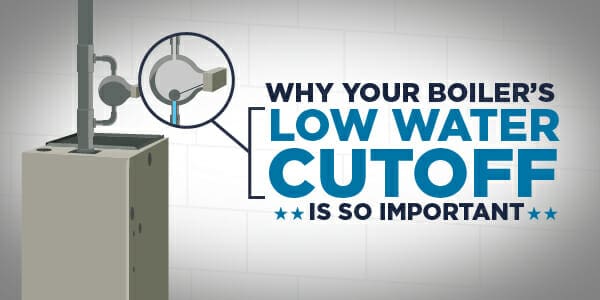
Why Your Boiler’s Low Water Cutoff is So Important
Have you ever put the kettle on, walked into another room, and forgotten all about it?
If you don’t have a whistling kettle–and sometimes even if you do–this can be an easy mistake to make. The repercussions of an error like this can be relatively harmless (you boil up all your water), expensive (you crack a glass stovetop), or disastrous (the kitchen catches fire).
Imagine if your kettle had a device that shut the burner off right before all of the water boiled off?
Think of the low-water cutoff valve (LWCO) on your boiler as just that device, but for your hot water or steam heating system instead of your tea kettle.
In order to operate, your hot water or steam heating system (commonly referred to as a ‘boiler’) needs water to operate properly. If a pipe bursts or some other issue causes the water level to drop below a certain level, then your boiler could “dry fire”, and that’s when the potential for a bigger problem to occur. Water not only provides heat for your home or business, but it also allows the system to operate at a safe temperature. Without it the system can overheat and stop functioning – or worse.
The scary thing about that is if you think your system is not providing enough heat to your home, you’ll turn up the thermostat, making the boiler work harder and possibly causing it to run hotter than it should. This can ruin the boiler or, much worse, build up pressure to the point where an explosion is possible.
So that’s why a (functioning and maintained) low-water cutoff valve is so important: It acts as a safety device and shuts your boiler down before it dry-fires itself into oblivion.
Here are a few other things to know about low-water cutoffs in your boiler.
Where it’s located.
The cutoff valve itself could be located anywhere on or near the boiler but should be at or above the minimum safe water level (as specified by the boiler manufacturer).
What makes low-water cutoff mechanisms fail?
A number of issues can interfere with a functioning LWCO. One, of course, is shoddy maintenance (which we’ll talk more about in a minute). Additionally here are a few other common things that can cause unwanted problems:
Deposits — Water condensation can deposit minerals and solids near the valve or under it, which can block or trick the valve into thinking the water level is normal, or prevent the boiler from shutting off properly.
Age — Check with the manufacturer to determine how often they recommend replacing various parts of the boiler. When the valve or other parts get older–as with most things–they start to short out, leak, or fail.
Water loss — The LWCO detects low water levels, but ideally your water won’t really get too low. But leaks and faulty steam traps can lead to loss of water, which can strain the whole system and compromise the valve. So, again, regular maintenance is paramount.
Take care of your boiler.
Neglecting regular maintenance on this device and the heating system in general is obviously not a great idea. Having it serviced and maintained every year, which should include checking it and making sure everything is clean, clear, and free of rust or erosion is essential to ensuring your boiler doesn’t cause you expensive and dangerous problems. You should also check around the boiler periodically to make sure there are no leaks or puddles.
Do you have any other questions about your boiler’s low-water cutoff valve? Get in touch!
